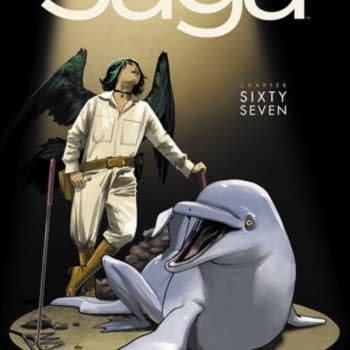Posted in: Comics, Recent Updates | Tagged: al ewing, Comics, entertainment, lee garbett, loki: agent of asgard, Marvel Comics, Nolan Woodward
A Live From The Comic Shop Review – What Does Loki: Agent of Asgard Want With The Truth?
Editorial duties have kept me from doing the Live From the Comic Shop column, but with summer coming up, that may not be all she wrote on the subject. Today, I had a particular interest in seeing how Loki: Agent of Asgard panned out in issue #4 so headed down to my local comic shop, Conquest Comics in New Jersey to write about it.
I was following the series and appreciating the characterization of Loki building on Journey into Mystery and Young Avengers and found his usual chaotic lifestyle and untangling of enmities entertaining as well as the Asgardian dialogue enough to keep reading, but issue #3 really piqued my curiosity due to my interest in medieval literature.
[*Full Spoilers for Loki: Agent of Asgard #3 below, and mild spoilers for #4]
I really wasn't expecting, when I opened the pages of #3 to find a full blown mythological tale about the treasure of he Volsungs, the cursed gold and Fafnir and was also impressed by the way in which writer Al Ewing, artist Lee Garbett, and colorist Nolan Woodward crafted the story into something with thematic values in harmony with the Marvel universe and Loki's characterization as a whole. They create something new out of the myth and handle in the short form what could easily stretch through a few issues, if not a graphic novel narrative. The fact that they could do this, but don't, and instead create a strong narrative hitting beats quickly and making significant points is a credit to their skills. The issue also establishes a mystery for the readers, why "old" Loki, sitting in an Asgard prison, needs to recraft or retell his past to make the future more amenable to him, and of course, leaves us wondering how this will all impact "young" Loki in the main narrative of the arc.
Ewing builds on many of the suggestions established by Kieron Gillen in Journey into Mystery about how intricate Loki's thinking can be in recrafting his own narrative, choosing between alternate versions based on plans requiring great effort but great rewards. Loki's not unlike a kind of reverse Sherlock Holmes and leaves you aware of the impact of detective fiction on Loki's reverse deductive thinking. And we sit back and wait for him to craft the perfect crime, which when complete will be seamlessly accepted as reality.
Issue #3 focuses, eventually, on managing to get a special sword forged which, bathed in the blood of the accursed and greedy dragon (once human) Fafnir, inspires "truth" in all who encounter it. Leaving, of course, a fair body count along the way of making that happen. The story that Ewing is drawing on hails from The Icelandic Prose Edda. Searching around for my favorite edition of the story, I fell victim to the typical curse of having too many books and couldn't find the nice full prosey version I was hankering to revisit. I did, however, find a book that had a shorter version of the story if you'd like to find it for yourself. It's The Prose Edda by Snorri Sturluson (though I'd usually write that Snorri Sturlsson), translated by Jean I. Young from University of California Press, 1994, pages 110-115 for the most part. It tells the story of Ottir, the shape-changer, his father, and brothers, including Fafnir, the involement of the hero Sigurd to capture Fafnir's gold and the forging, most importantly for this Loki story, of the sword Gram. Ewing has compressed that tale into issue #3, made a young Odin the hero who initiates the pattern of the story, and has some amusing commentary on the characterization of the hero Sigurd.
But let's focus on the sword Gram and the fact that, if you think about it, Loki is "making" this key mythological story happen by prompting it as a catalyst in full knowledge of what serves him as the outcome. He wants that sword. Why, we don't fully know yet. But the amount of energy he's putting into it should make us aware that it's going to serve a big purpose. The dwarf Andvari, originally in possessing of the vast treasure later taken by Fafnir, places a curse on the hoard itself that is invested in "bringing out the true natures" of those who possess it. That's the first step toward Gram, a kind of foreshadowing of what the sword will do. It's interesting to speculate what that gold might do to Loki, who is always thoroughly himself to the reader though not always in a publicly obvious way. But he doesn't keep the treasure—that is of no interest to him other than moving his plans along. Revenge-driven brother to Fafnir and Otr, Hreidmar, forges Gram though the process is not complete in creating a fully blown magical object.
Ewing writes "Gram's blade, steeped as it had been in truth-cursed blood was now as piercing as the truth itself", and being stabbed by the sword reveals terrible truths to Hreidmar about himself. The nickname of the sword Gram is also "Asgard's bane", which in the context of Loki stories is very ominous indeed. Loki calls in a promise made by the young Odin to lock the sword away for centuries in a cave until he can retrieve it at the right time. And so, Loki rewrites his own history, giving himself, and the hero Sigurd, access in future time. What does Loki want with something that unerring reveals the "truth"? Surely that's anathema to a creature like Loki. And yet the answer must loosely be that Loki has many tools and weapons at his disposal and will readily use them in opportunistic fashion and as unnerving as it is to recognize: the truth is one of Loki's weapons too.
Issue #4 takes us back to the "present" with Sigurd now in possession of the "sword of truth", and back to young Loki in Manhattan. And now the resonant alarms should go off because he's in company of a young lady, Verity (nice name) who can always see through lies, a kind of human version of Gram. She even sees "ulterior motives" in Loki's motives. Old Loki has in fact made life a little difficult for young Loki by leaving the sword for Sigurd to find, since Loki has been commissioned to send Sigurd "home" in his role as an "agent" of Asgard. But for us, things are never what they seem. What would happen if Loki gets stabbed by the Sword of Truth? Is this the outcome Old Loki was hoping for? Not in the way we might think. How is "truth" part of these final shenanigans? It's imperative that Sigurd, holding the sword, feels that no-one can lie to him so that Loki can tag along and twist things to his own devices and it all turns on a "contract" which again purports to be the truth and binding which could have big repercussions on Loki's abilities in the future.
As we might have suspected, the truth is just a way to manipulate others into walking confidently into Loki's traps. But I'll leave one final suggestion: at the conclusion of issue #4 Loki seems to have a change of heart about what he's doing working as an agent of Asgard. Perhaps he was stabbed by the sword after all. We have some suggestion that he has been reminded of his crimes in the past and his sudden concern seems to be for the prisoners of Asgard's dungeon where….in issue #3 Old Loki is imprisoned. This is all getting very interesting.
Perhaps if we think of the Sword of Truth as bringing out "true natures" than that is what is really at work here, encouraging people to be more themselves. And in that sense, Loki may not be able to hide any part of his nature from himself anymore, good or bad. All paths lead to Asgard at that point: and to judge from the past, mayhem will ensue. Loki's division in personality has been compromised and that means the floodgates are poised to open. All eyes turn to those dungeons, the origin point of so much trouble for the nine realms…
Special thanks to Conquest Comics in New Jersey. You can find their Facebook page here. They are currently dominating POP vinyl collectibles with their White Phoenix exclusive and now have their Metallic Harley Quinn exclusive in stock.
Hannah Means-Shannon is EIC at Bleeding Cool and @hannahmenzies on Twitter


















